Disfluency Effect on Education
VerifiedAdded on 2023/05/30
|13
|3171
|257
AI Summary
This research investigates the impact of disfluency on educational outcomes. It aims to determine whether disfluent information is more retained for longer times compared to fluent information. The study involved 30 participants and utilized descriptive and inferential tools for data analysis. The results showed that participants in the disfluent condition recalled 12% more information than those in the fluent condition.
Contribute Materials
Your contribution can guide someone’s learning journey. Share your
documents today.
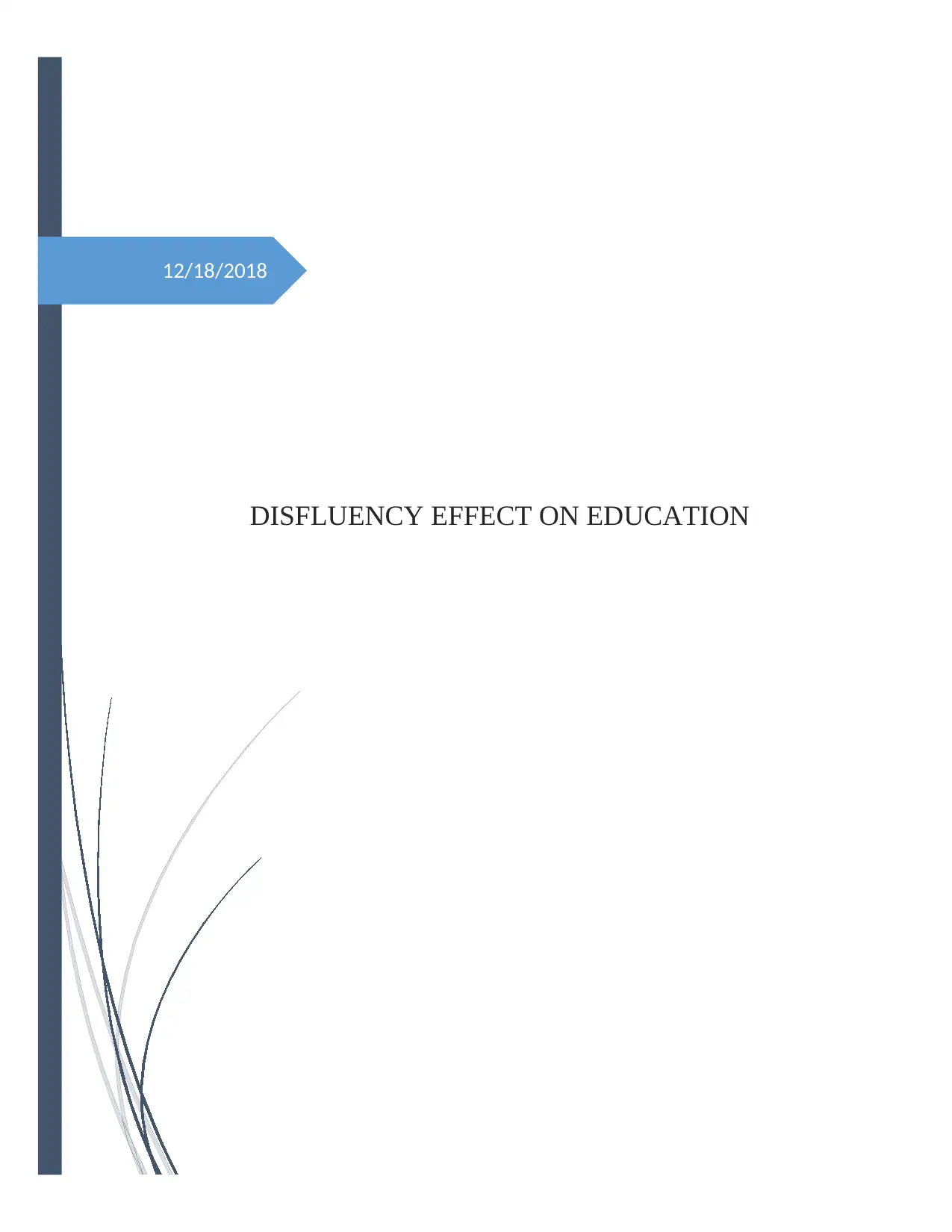
12/18/2018
DISFLUENCY EFFECT ON EDUCATION
DISFLUENCY EFFECT ON EDUCATION
Secure Best Marks with AI Grader
Need help grading? Try our AI Grader for instant feedback on your assignments.
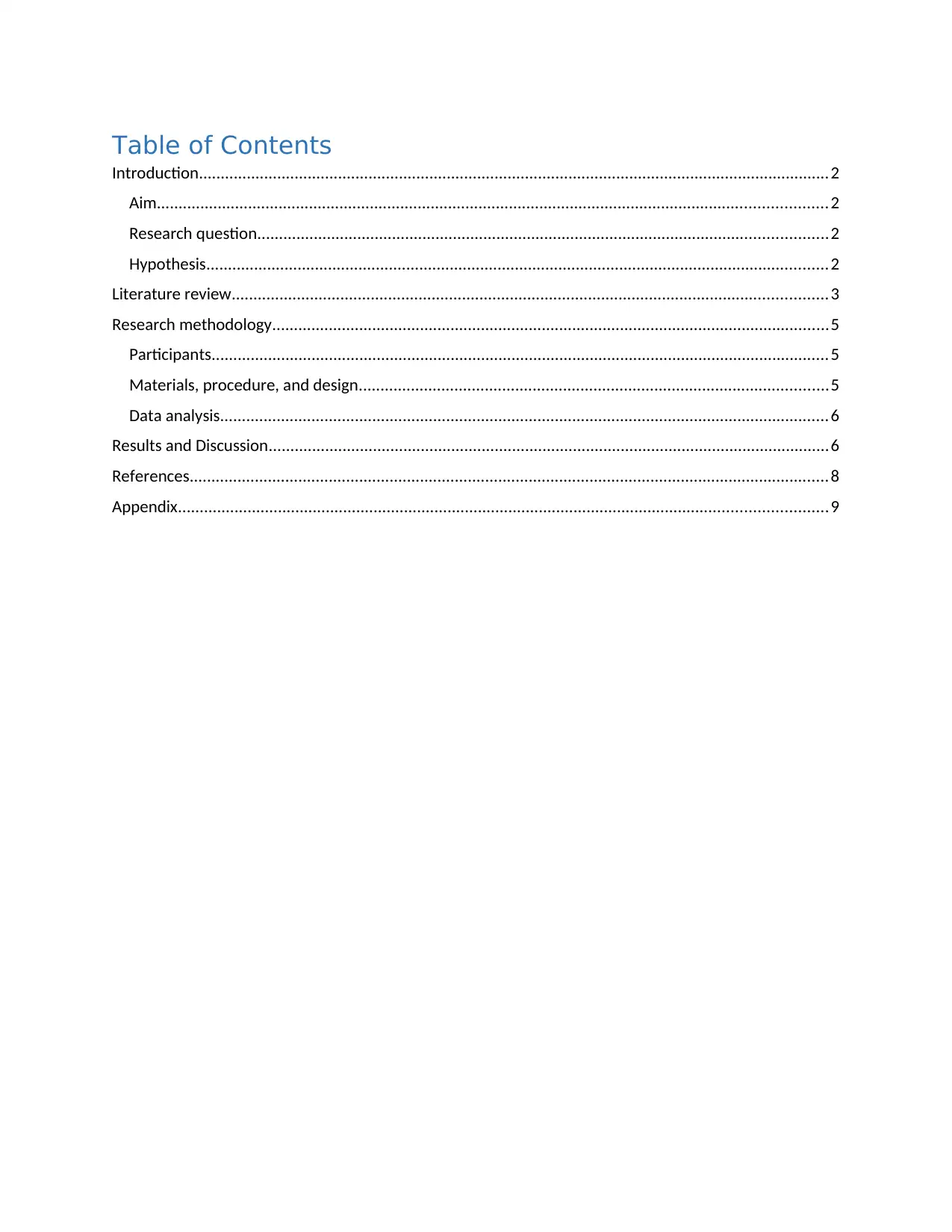
Table of Contents
Introduction.................................................................................................................................................2
Aim..........................................................................................................................................................2
Research question...................................................................................................................................2
Hypothesis...............................................................................................................................................2
Literature review.........................................................................................................................................3
Research methodology................................................................................................................................5
Participants..............................................................................................................................................5
Materials, procedure, and design............................................................................................................5
Data analysis............................................................................................................................................6
Results and Discussion.................................................................................................................................6
References...................................................................................................................................................8
Appendix.....................................................................................................................................................9
Introduction.................................................................................................................................................2
Aim..........................................................................................................................................................2
Research question...................................................................................................................................2
Hypothesis...............................................................................................................................................2
Literature review.........................................................................................................................................3
Research methodology................................................................................................................................5
Participants..............................................................................................................................................5
Materials, procedure, and design............................................................................................................5
Data analysis............................................................................................................................................6
Results and Discussion.................................................................................................................................6
References...................................................................................................................................................8
Appendix.....................................................................................................................................................9
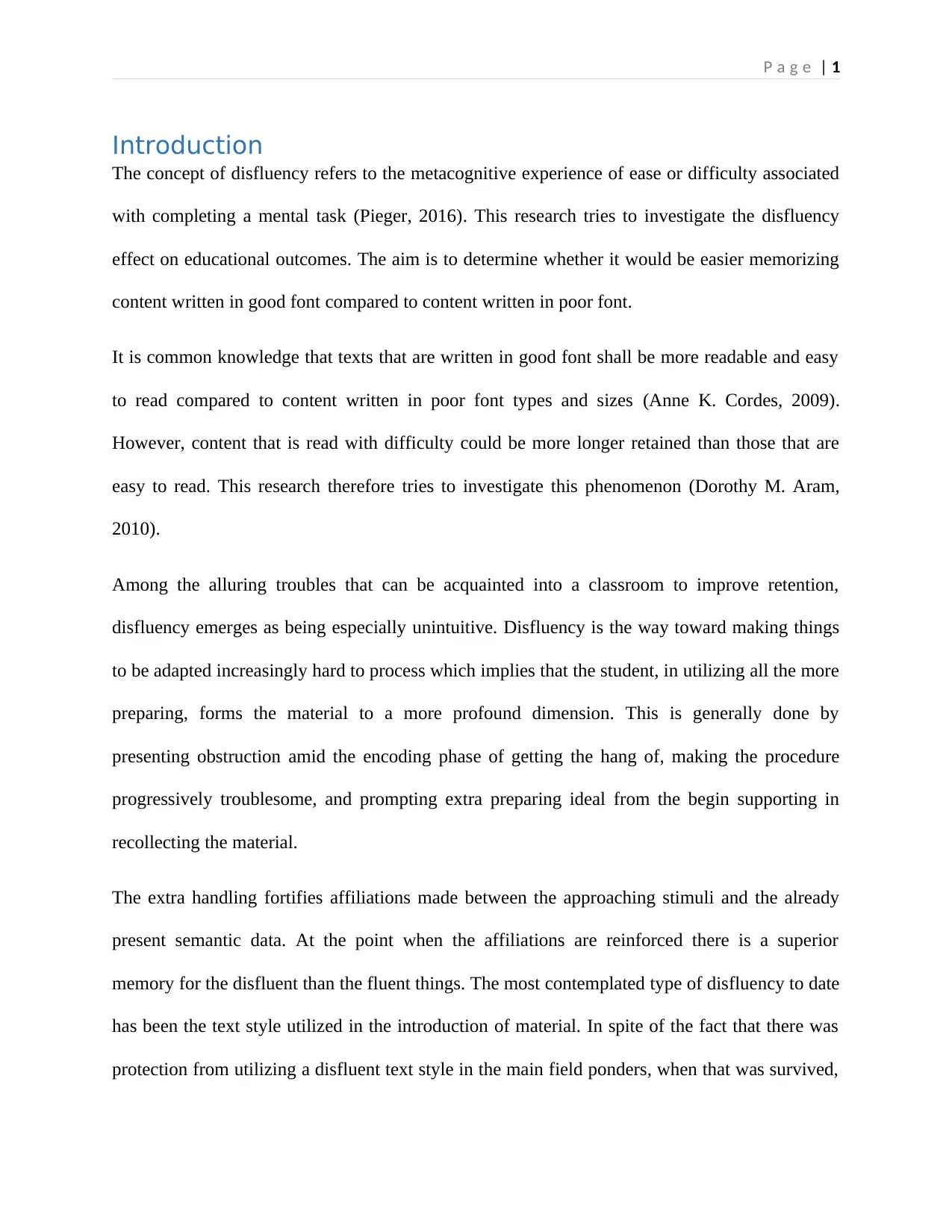
P a g e | 1
Introduction
The concept of disfluency refers to the metacognitive experience of ease or difficulty associated
with completing a mental task (Pieger, 2016). This research tries to investigate the disfluency
effect on educational outcomes. The aim is to determine whether it would be easier memorizing
content written in good font compared to content written in poor font.
It is common knowledge that texts that are written in good font shall be more readable and easy
to read compared to content written in poor font types and sizes (Anne K. Cordes, 2009).
However, content that is read with difficulty could be more longer retained than those that are
easy to read. This research therefore tries to investigate this phenomenon (Dorothy M. Aram,
2010).
Among the alluring troubles that can be acquainted into a classroom to improve retention,
disfluency emerges as being especially unintuitive. Disfluency is the way toward making things
to be adapted increasingly hard to process which implies that the student, in utilizing all the more
preparing, forms the material to a more profound dimension. This is generally done by
presenting obstruction amid the encoding phase of getting the hang of, making the procedure
progressively troublesome, and prompting extra preparing ideal from the begin supporting in
recollecting the material.
The extra handling fortifies affiliations made between the approaching stimuli and the already
present semantic data. At the point when the affiliations are reinforced there is a superior
memory for the disfluent than the fluent things. The most contemplated type of disfluency to date
has been the text style utilized in the introduction of material. In spite of the fact that there was
protection from utilizing a disfluent text style in the main field ponders, when that was survived,
Introduction
The concept of disfluency refers to the metacognitive experience of ease or difficulty associated
with completing a mental task (Pieger, 2016). This research tries to investigate the disfluency
effect on educational outcomes. The aim is to determine whether it would be easier memorizing
content written in good font compared to content written in poor font.
It is common knowledge that texts that are written in good font shall be more readable and easy
to read compared to content written in poor font types and sizes (Anne K. Cordes, 2009).
However, content that is read with difficulty could be more longer retained than those that are
easy to read. This research therefore tries to investigate this phenomenon (Dorothy M. Aram,
2010).
Among the alluring troubles that can be acquainted into a classroom to improve retention,
disfluency emerges as being especially unintuitive. Disfluency is the way toward making things
to be adapted increasingly hard to process which implies that the student, in utilizing all the more
preparing, forms the material to a more profound dimension. This is generally done by
presenting obstruction amid the encoding phase of getting the hang of, making the procedure
progressively troublesome, and prompting extra preparing ideal from the begin supporting in
recollecting the material.
The extra handling fortifies affiliations made between the approaching stimuli and the already
present semantic data. At the point when the affiliations are reinforced there is a superior
memory for the disfluent than the fluent things. The most contemplated type of disfluency to date
has been the text style utilized in the introduction of material. In spite of the fact that there was
protection from utilizing a disfluent text style in the main field ponders, when that was survived,
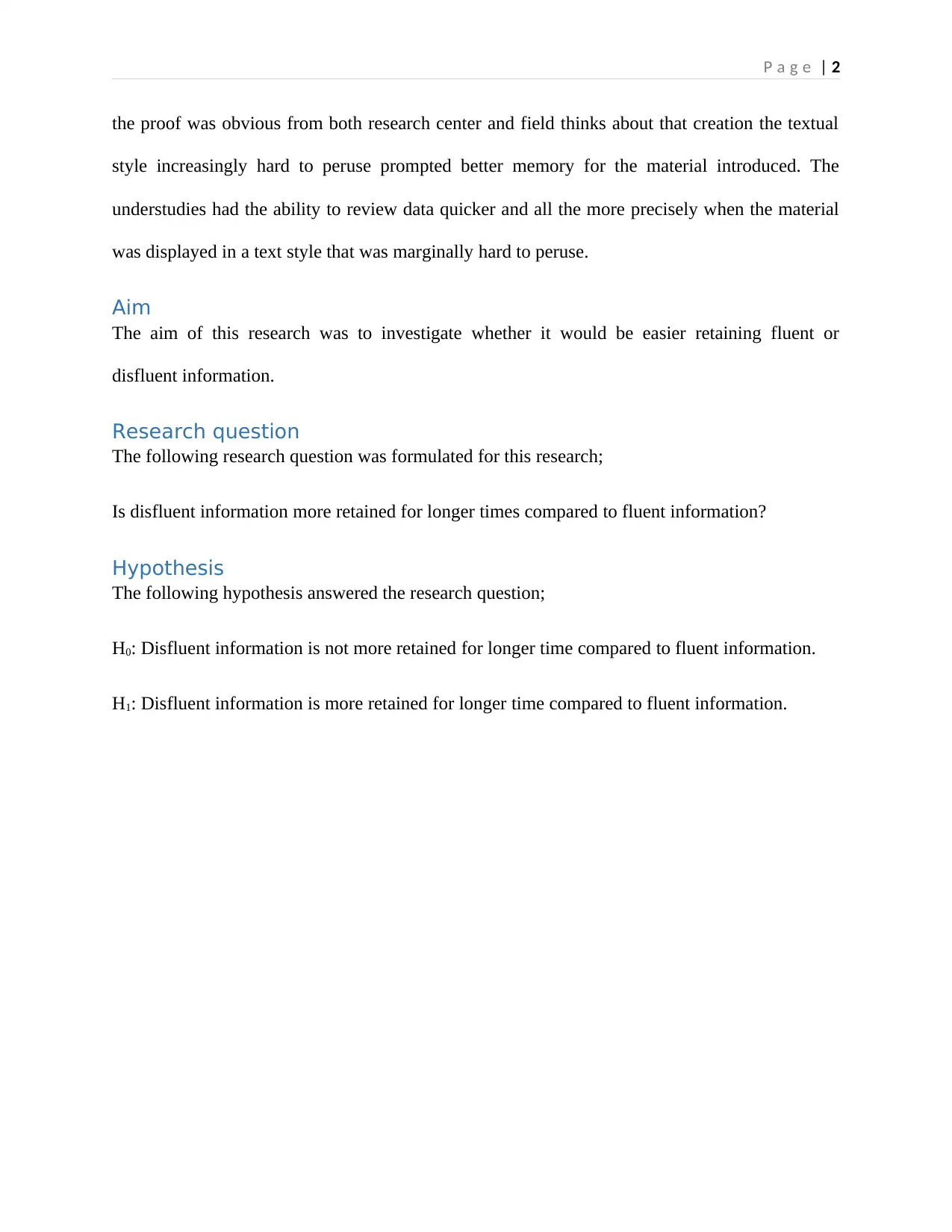
P a g e | 2
the proof was obvious from both research center and field thinks about that creation the textual
style increasingly hard to peruse prompted better memory for the material introduced. The
understudies had the ability to review data quicker and all the more precisely when the material
was displayed in a text style that was marginally hard to peruse.
Aim
The aim of this research was to investigate whether it would be easier retaining fluent or
disfluent information.
Research question
The following research question was formulated for this research;
Is disfluent information more retained for longer times compared to fluent information?
Hypothesis
The following hypothesis answered the research question;
H0: Disfluent information is not more retained for longer time compared to fluent information.
H1: Disfluent information is more retained for longer time compared to fluent information.
the proof was obvious from both research center and field thinks about that creation the textual
style increasingly hard to peruse prompted better memory for the material introduced. The
understudies had the ability to review data quicker and all the more precisely when the material
was displayed in a text style that was marginally hard to peruse.
Aim
The aim of this research was to investigate whether it would be easier retaining fluent or
disfluent information.
Research question
The following research question was formulated for this research;
Is disfluent information more retained for longer times compared to fluent information?
Hypothesis
The following hypothesis answered the research question;
H0: Disfluent information is not more retained for longer time compared to fluent information.
H1: Disfluent information is more retained for longer time compared to fluent information.
Secure Best Marks with AI Grader
Need help grading? Try our AI Grader for instant feedback on your assignments.
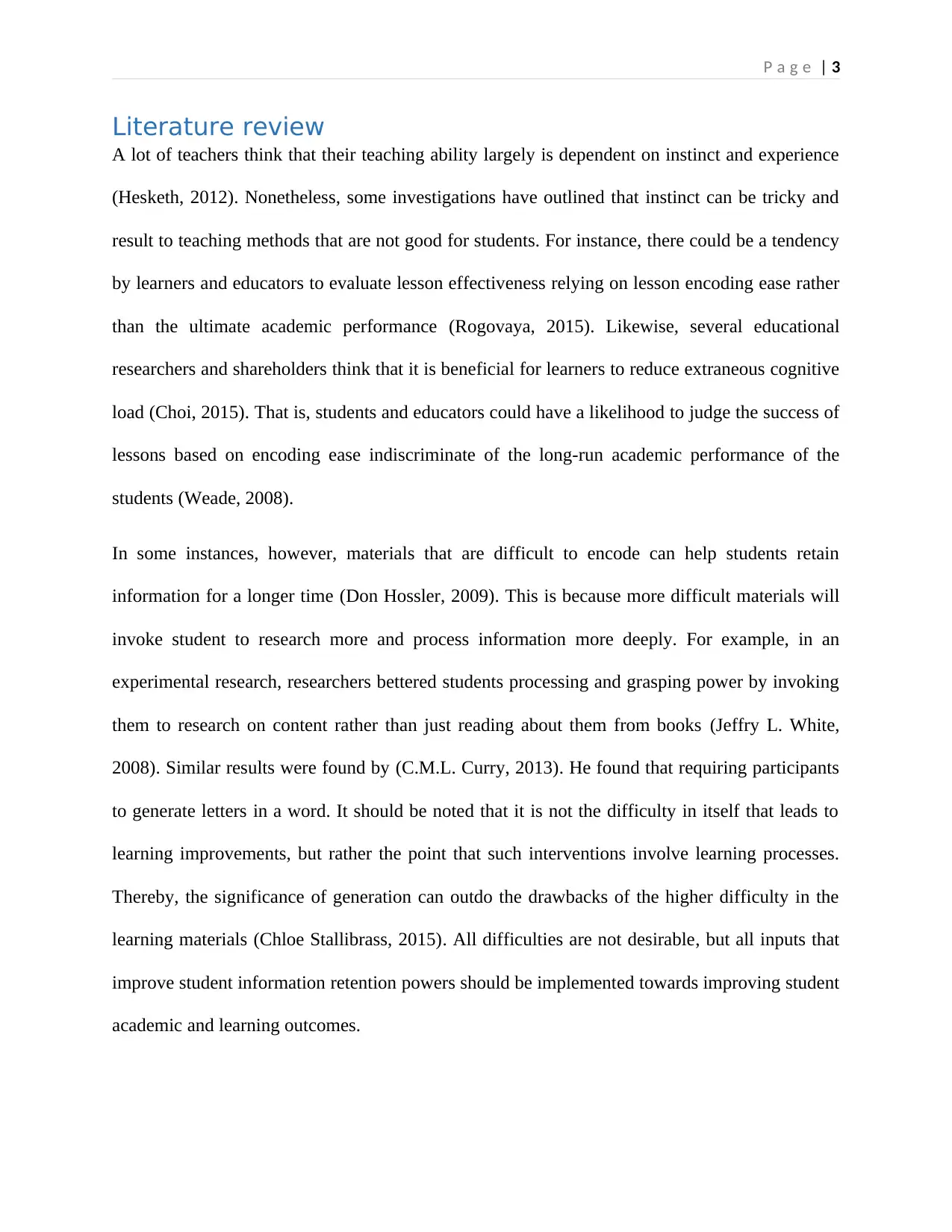
P a g e | 3
Literature review
A lot of teachers think that their teaching ability largely is dependent on instinct and experience
(Hesketh, 2012). Nonetheless, some investigations have outlined that instinct can be tricky and
result to teaching methods that are not good for students. For instance, there could be a tendency
by learners and educators to evaluate lesson effectiveness relying on lesson encoding ease rather
than the ultimate academic performance (Rogovaya, 2015). Likewise, several educational
researchers and shareholders think that it is beneficial for learners to reduce extraneous cognitive
load (Choi, 2015). That is, students and educators could have a likelihood to judge the success of
lessons based on encoding ease indiscriminate of the long-run academic performance of the
students (Weade, 2008).
In some instances, however, materials that are difficult to encode can help students retain
information for a longer time (Don Hossler, 2009). This is because more difficult materials will
invoke student to research more and process information more deeply. For example, in an
experimental research, researchers bettered students processing and grasping power by invoking
them to research on content rather than just reading about them from books (Jeffry L. White,
2008). Similar results were found by (C.M.L. Curry, 2013). He found that requiring participants
to generate letters in a word. It should be noted that it is not the difficulty in itself that leads to
learning improvements, but rather the point that such interventions involve learning processes.
Thereby, the significance of generation can outdo the drawbacks of the higher difficulty in the
learning materials (Chloe Stallibrass, 2015). All difficulties are not desirable, but all inputs that
improve student information retention powers should be implemented towards improving student
academic and learning outcomes.
Literature review
A lot of teachers think that their teaching ability largely is dependent on instinct and experience
(Hesketh, 2012). Nonetheless, some investigations have outlined that instinct can be tricky and
result to teaching methods that are not good for students. For instance, there could be a tendency
by learners and educators to evaluate lesson effectiveness relying on lesson encoding ease rather
than the ultimate academic performance (Rogovaya, 2015). Likewise, several educational
researchers and shareholders think that it is beneficial for learners to reduce extraneous cognitive
load (Choi, 2015). That is, students and educators could have a likelihood to judge the success of
lessons based on encoding ease indiscriminate of the long-run academic performance of the
students (Weade, 2008).
In some instances, however, materials that are difficult to encode can help students retain
information for a longer time (Don Hossler, 2009). This is because more difficult materials will
invoke student to research more and process information more deeply. For example, in an
experimental research, researchers bettered students processing and grasping power by invoking
them to research on content rather than just reading about them from books (Jeffry L. White,
2008). Similar results were found by (C.M.L. Curry, 2013). He found that requiring participants
to generate letters in a word. It should be noted that it is not the difficulty in itself that leads to
learning improvements, but rather the point that such interventions involve learning processes.
Thereby, the significance of generation can outdo the drawbacks of the higher difficulty in the
learning materials (Chloe Stallibrass, 2015). All difficulties are not desirable, but all inputs that
improve student information retention powers should be implemented towards improving student
academic and learning outcomes.
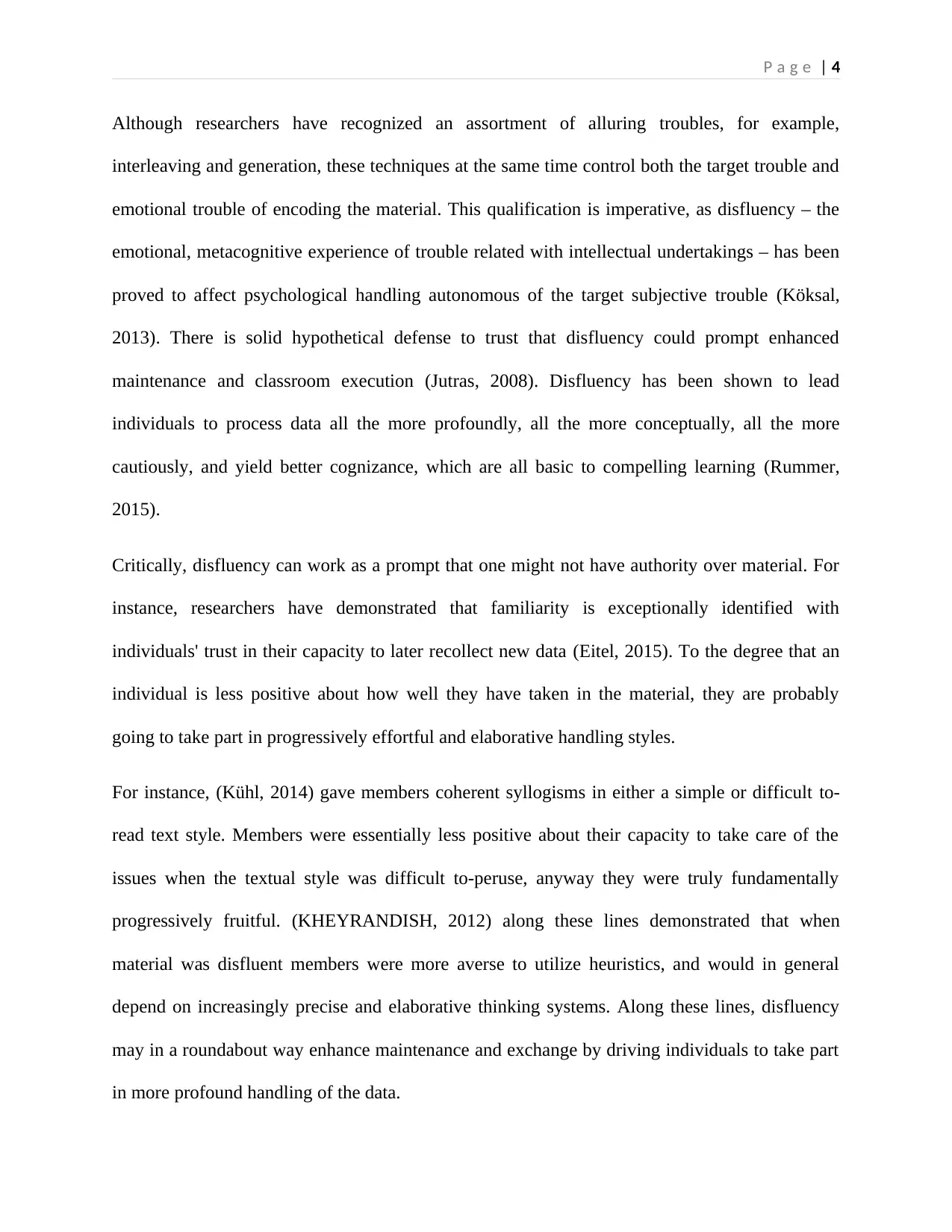
P a g e | 4
Although researchers have recognized an assortment of alluring troubles, for example,
interleaving and generation, these techniques at the same time control both the target trouble and
emotional trouble of encoding the material. This qualification is imperative, as disfluency – the
emotional, metacognitive experience of trouble related with intellectual undertakings – has been
proved to affect psychological handling autonomous of the target subjective trouble (Köksal,
2013). There is solid hypothetical defense to trust that disfluency could prompt enhanced
maintenance and classroom execution (Jutras, 2008). Disfluency has been shown to lead
individuals to process data all the more profoundly, all the more conceptually, all the more
cautiously, and yield better cognizance, which are all basic to compelling learning (Rummer,
2015).
Critically, disfluency can work as a prompt that one might not have authority over material. For
instance, researchers have demonstrated that familiarity is exceptionally identified with
individuals' trust in their capacity to later recollect new data (Eitel, 2015). To the degree that an
individual is less positive about how well they have taken in the material, they are probably
going to take part in progressively effortful and elaborative handling styles.
For instance, (Kühl, 2014) gave members coherent syllogisms in either a simple or difficult to-
read text style. Members were essentially less positive about their capacity to take care of the
issues when the textual style was difficult to-peruse, anyway they were truly fundamentally
progressively fruitful. (KHEYRANDISH, 2012) along these lines demonstrated that when
material was disfluent members were more averse to utilize heuristics, and would in general
depend on increasingly precise and elaborative thinking systems. Along these lines, disfluency
may in a roundabout way enhance maintenance and exchange by driving individuals to take part
in more profound handling of the data.
Although researchers have recognized an assortment of alluring troubles, for example,
interleaving and generation, these techniques at the same time control both the target trouble and
emotional trouble of encoding the material. This qualification is imperative, as disfluency – the
emotional, metacognitive experience of trouble related with intellectual undertakings – has been
proved to affect psychological handling autonomous of the target subjective trouble (Köksal,
2013). There is solid hypothetical defense to trust that disfluency could prompt enhanced
maintenance and classroom execution (Jutras, 2008). Disfluency has been shown to lead
individuals to process data all the more profoundly, all the more conceptually, all the more
cautiously, and yield better cognizance, which are all basic to compelling learning (Rummer,
2015).
Critically, disfluency can work as a prompt that one might not have authority over material. For
instance, researchers have demonstrated that familiarity is exceptionally identified with
individuals' trust in their capacity to later recollect new data (Eitel, 2015). To the degree that an
individual is less positive about how well they have taken in the material, they are probably
going to take part in progressively effortful and elaborative handling styles.
For instance, (Kühl, 2014) gave members coherent syllogisms in either a simple or difficult to-
read text style. Members were essentially less positive about their capacity to take care of the
issues when the textual style was difficult to-peruse, anyway they were truly fundamentally
progressively fruitful. (KHEYRANDISH, 2012) along these lines demonstrated that when
material was disfluent members were more averse to utilize heuristics, and would in general
depend on increasingly precise and elaborative thinking systems. Along these lines, disfluency
may in a roundabout way enhance maintenance and exchange by driving individuals to take part
in more profound handling of the data.
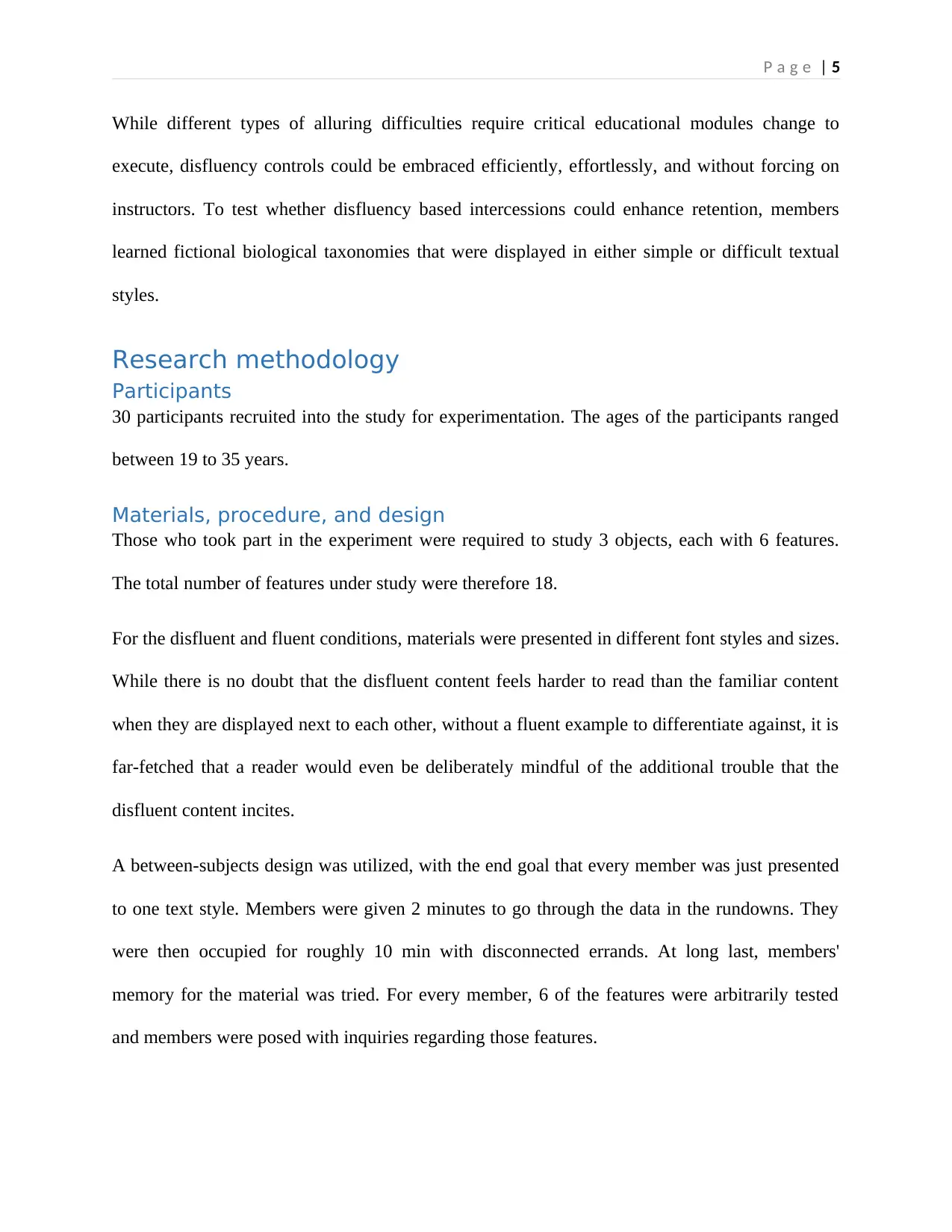
P a g e | 5
While different types of alluring difficulties require critical educational modules change to
execute, disfluency controls could be embraced efficiently, effortlessly, and without forcing on
instructors. To test whether disfluency based intercessions could enhance retention, members
learned fictional biological taxonomies that were displayed in either simple or difficult textual
styles.
Research methodology
Participants
30 participants recruited into the study for experimentation. The ages of the participants ranged
between 19 to 35 years.
Materials, procedure, and design
Those who took part in the experiment were required to study 3 objects, each with 6 features.
The total number of features under study were therefore 18.
For the disfluent and fluent conditions, materials were presented in different font styles and sizes.
While there is no doubt that the disfluent content feels harder to read than the familiar content
when they are displayed next to each other, without a fluent example to differentiate against, it is
far-fetched that a reader would even be deliberately mindful of the additional trouble that the
disfluent content incites.
A between-subjects design was utilized, with the end goal that every member was just presented
to one text style. Members were given 2 minutes to go through the data in the rundowns. They
were then occupied for roughly 10 min with disconnected errands. At long last, members'
memory for the material was tried. For every member, 6 of the features were arbitrarily tested
and members were posed with inquiries regarding those features.
While different types of alluring difficulties require critical educational modules change to
execute, disfluency controls could be embraced efficiently, effortlessly, and without forcing on
instructors. To test whether disfluency based intercessions could enhance retention, members
learned fictional biological taxonomies that were displayed in either simple or difficult textual
styles.
Research methodology
Participants
30 participants recruited into the study for experimentation. The ages of the participants ranged
between 19 to 35 years.
Materials, procedure, and design
Those who took part in the experiment were required to study 3 objects, each with 6 features.
The total number of features under study were therefore 18.
For the disfluent and fluent conditions, materials were presented in different font styles and sizes.
While there is no doubt that the disfluent content feels harder to read than the familiar content
when they are displayed next to each other, without a fluent example to differentiate against, it is
far-fetched that a reader would even be deliberately mindful of the additional trouble that the
disfluent content incites.
A between-subjects design was utilized, with the end goal that every member was just presented
to one text style. Members were given 2 minutes to go through the data in the rundowns. They
were then occupied for roughly 10 min with disconnected errands. At long last, members'
memory for the material was tried. For every member, 6 of the features were arbitrarily tested
and members were posed with inquiries regarding those features.
Paraphrase This Document
Need a fresh take? Get an instant paraphrase of this document with our AI Paraphraser
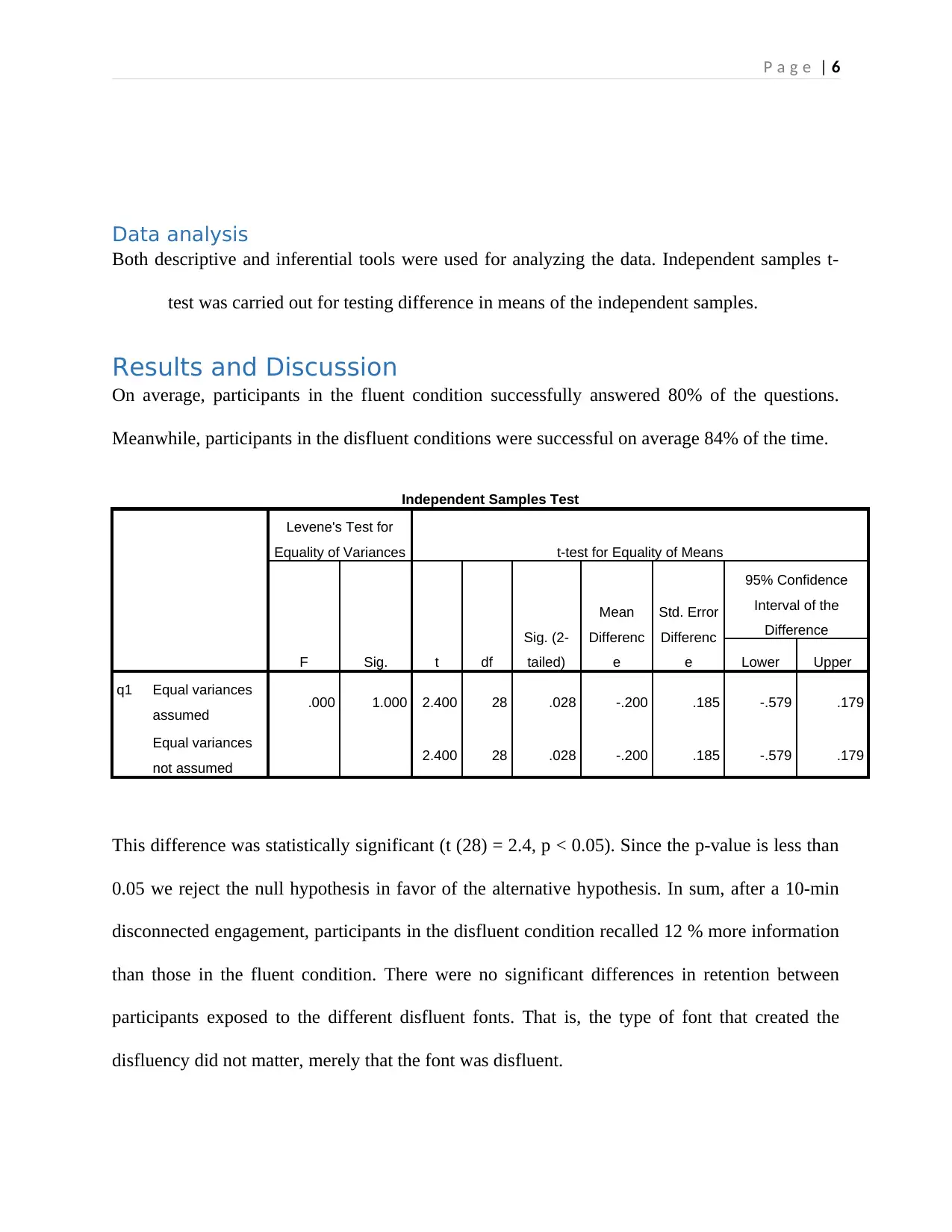
P a g e | 6
Data analysis
Both descriptive and inferential tools were used for analyzing the data. Independent samples t-
test was carried out for testing difference in means of the independent samples.
Results and Discussion
On average, participants in the fluent condition successfully answered 80% of the questions.
Meanwhile, participants in the disfluent conditions were successful on average 84% of the time.
Independent Samples Test
Levene's Test for
Equality of Variances t-test for Equality of Means
F Sig. t df
Sig. (2-
tailed)
Mean
Differenc
e
Std. Error
Differenc
e
95% Confidence
Interval of the
Difference
Lower Upper
q1 Equal variances
assumed .000 1.000 2.400 28 .028 -.200 .185 -.579 .179
Equal variances
not assumed 2.400 28 .028 -.200 .185 -.579 .179
This difference was statistically significant (t (28) = 2.4, p < 0.05). Since the p-value is less than
0.05 we reject the null hypothesis in favor of the alternative hypothesis. In sum, after a 10-min
disconnected engagement, participants in the disfluent condition recalled 12 % more information
than those in the fluent condition. There were no significant differences in retention between
participants exposed to the different disfluent fonts. That is, the type of font that created the
disfluency did not matter, merely that the font was disfluent.
Data analysis
Both descriptive and inferential tools were used for analyzing the data. Independent samples t-
test was carried out for testing difference in means of the independent samples.
Results and Discussion
On average, participants in the fluent condition successfully answered 80% of the questions.
Meanwhile, participants in the disfluent conditions were successful on average 84% of the time.
Independent Samples Test
Levene's Test for
Equality of Variances t-test for Equality of Means
F Sig. t df
Sig. (2-
tailed)
Mean
Differenc
e
Std. Error
Differenc
e
95% Confidence
Interval of the
Difference
Lower Upper
q1 Equal variances
assumed .000 1.000 2.400 28 .028 -.200 .185 -.579 .179
Equal variances
not assumed 2.400 28 .028 -.200 .185 -.579 .179
This difference was statistically significant (t (28) = 2.4, p < 0.05). Since the p-value is less than
0.05 we reject the null hypothesis in favor of the alternative hypothesis. In sum, after a 10-min
disconnected engagement, participants in the disfluent condition recalled 12 % more information
than those in the fluent condition. There were no significant differences in retention between
participants exposed to the different disfluent fonts. That is, the type of font that created the
disfluency did not matter, merely that the font was disfluent.
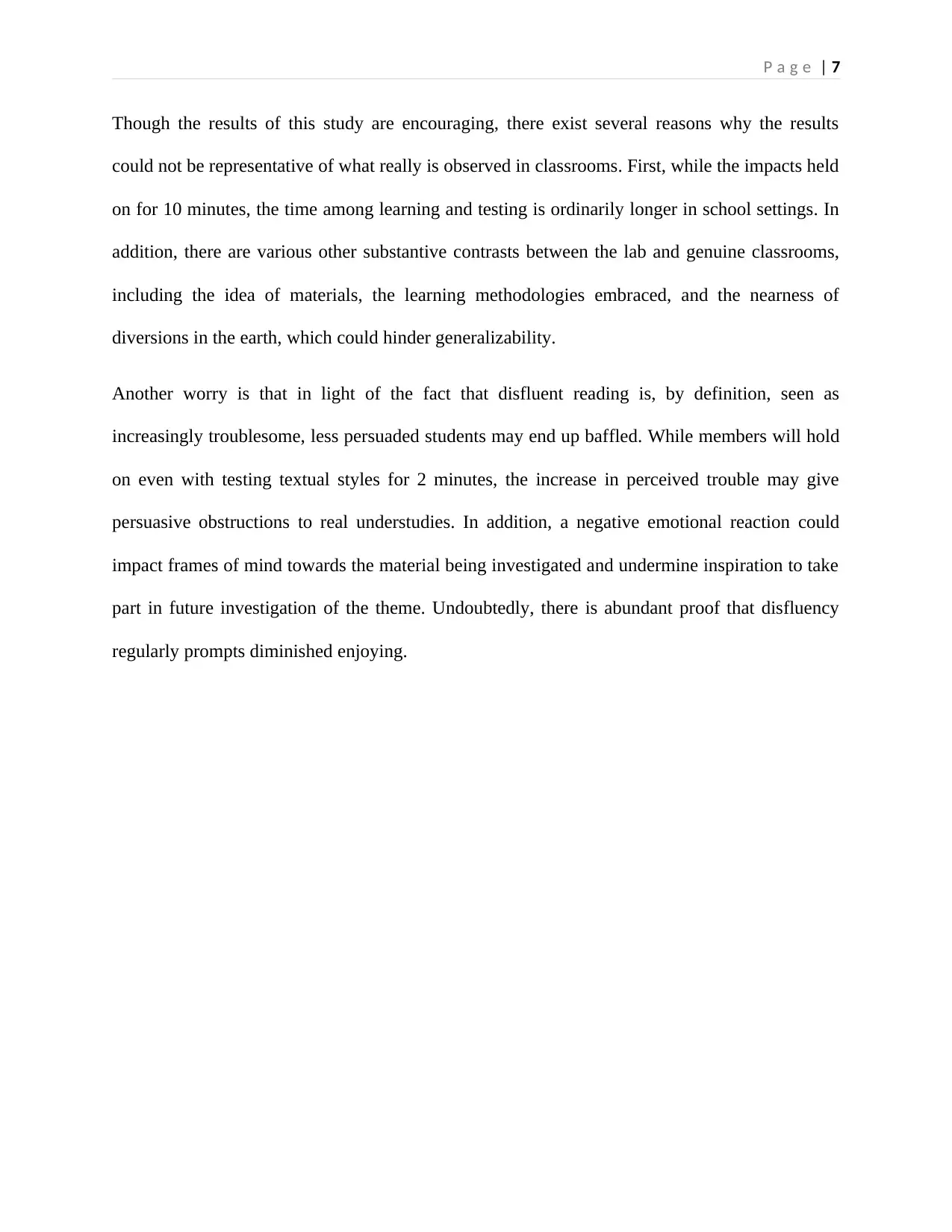
P a g e | 7
Though the results of this study are encouraging, there exist several reasons why the results
could not be representative of what really is observed in classrooms. First, while the impacts held
on for 10 minutes, the time among learning and testing is ordinarily longer in school settings. In
addition, there are various other substantive contrasts between the lab and genuine classrooms,
including the idea of materials, the learning methodologies embraced, and the nearness of
diversions in the earth, which could hinder generalizability.
Another worry is that in light of the fact that disfluent reading is, by definition, seen as
increasingly troublesome, less persuaded students may end up baffled. While members will hold
on even with testing textual styles for 2 minutes, the increase in perceived trouble may give
persuasive obstructions to real understudies. In addition, a negative emotional reaction could
impact frames of mind towards the material being investigated and undermine inspiration to take
part in future investigation of the theme. Undoubtedly, there is abundant proof that disfluency
regularly prompts diminished enjoying.
Though the results of this study are encouraging, there exist several reasons why the results
could not be representative of what really is observed in classrooms. First, while the impacts held
on for 10 minutes, the time among learning and testing is ordinarily longer in school settings. In
addition, there are various other substantive contrasts between the lab and genuine classrooms,
including the idea of materials, the learning methodologies embraced, and the nearness of
diversions in the earth, which could hinder generalizability.
Another worry is that in light of the fact that disfluent reading is, by definition, seen as
increasingly troublesome, less persuaded students may end up baffled. While members will hold
on even with testing textual styles for 2 minutes, the increase in perceived trouble may give
persuasive obstructions to real understudies. In addition, a negative emotional reaction could
impact frames of mind towards the material being investigated and undermine inspiration to take
part in future investigation of the theme. Undoubtedly, there is abundant proof that disfluency
regularly prompts diminished enjoying.
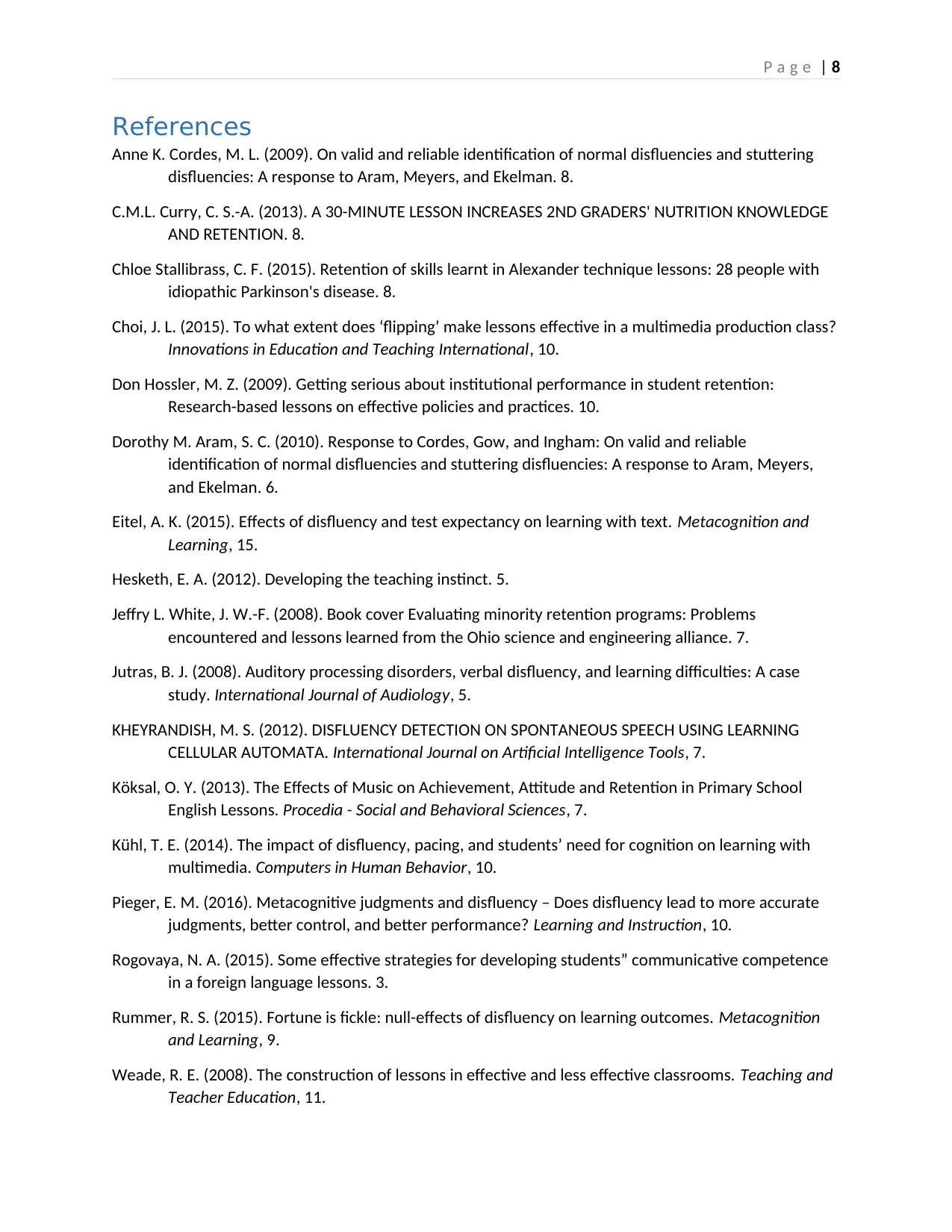
P a g e | 8
References
Anne K. Cordes, M. L. (2009). On valid and reliable identification of normal disfluencies and stuttering
disfluencies: A response to Aram, Meyers, and Ekelman. 8.
C.M.L. Curry, C. S.-A. (2013). A 30-MINUTE LESSON INCREASES 2ND GRADERS' NUTRITION KNOWLEDGE
AND RETENTION. 8.
Chloe Stallibrass, C. F. (2015). Retention of skills learnt in Alexander technique lessons: 28 people with
idiopathic Parkinson's disease. 8.
Choi, J. L. (2015). To what extent does ‘flipping’ make lessons effective in a multimedia production class?
Innovations in Education and Teaching International, 10.
Don Hossler, M. Z. (2009). Getting serious about institutional performance in student retention:
Research-based lessons on effective policies and practices. 10.
Dorothy M. Aram, S. C. (2010). Response to Cordes, Gow, and Ingham: On valid and reliable
identification of normal disfluencies and stuttering disfluencies: A response to Aram, Meyers,
and Ekelman. 6.
Eitel, A. K. (2015). Effects of disfluency and test expectancy on learning with text. Metacognition and
Learning, 15.
Hesketh, E. A. (2012). Developing the teaching instinct. 5.
Jeffry L. White, J. W.-F. (2008). Book cover Evaluating minority retention programs: Problems
encountered and lessons learned from the Ohio science and engineering alliance. 7.
Jutras, B. J. (2008). Auditory processing disorders, verbal disfluency, and learning difficulties: A case
study. International Journal of Audiology, 5.
KHEYRANDISH, M. S. (2012). DISFLUENCY DETECTION ON SPONTANEOUS SPEECH USING LEARNING
CELLULAR AUTOMATA. International Journal on Artificial Intelligence Tools, 7.
Köksal, O. Y. (2013). The Effects of Music on Achievement, Attitude and Retention in Primary School
English Lessons. Procedia - Social and Behavioral Sciences, 7.
Kühl, T. E. (2014). The impact of disfluency, pacing, and students’ need for cognition on learning with
multimedia. Computers in Human Behavior, 10.
Pieger, E. M. (2016). Metacognitive judgments and disfluency – Does disfluency lead to more accurate
judgments, better control, and better performance? Learning and Instruction, 10.
Rogovaya, N. A. (2015). Some effective strategies for developing students” communicative competence
in a foreign language lessons. 3.
Rummer, R. S. (2015). Fortune is fickle: null-effects of disfluency on learning outcomes. Metacognition
and Learning, 9.
Weade, R. E. (2008). The construction of lessons in effective and less effective classrooms. Teaching and
Teacher Education, 11.
References
Anne K. Cordes, M. L. (2009). On valid and reliable identification of normal disfluencies and stuttering
disfluencies: A response to Aram, Meyers, and Ekelman. 8.
C.M.L. Curry, C. S.-A. (2013). A 30-MINUTE LESSON INCREASES 2ND GRADERS' NUTRITION KNOWLEDGE
AND RETENTION. 8.
Chloe Stallibrass, C. F. (2015). Retention of skills learnt in Alexander technique lessons: 28 people with
idiopathic Parkinson's disease. 8.
Choi, J. L. (2015). To what extent does ‘flipping’ make lessons effective in a multimedia production class?
Innovations in Education and Teaching International, 10.
Don Hossler, M. Z. (2009). Getting serious about institutional performance in student retention:
Research-based lessons on effective policies and practices. 10.
Dorothy M. Aram, S. C. (2010). Response to Cordes, Gow, and Ingham: On valid and reliable
identification of normal disfluencies and stuttering disfluencies: A response to Aram, Meyers,
and Ekelman. 6.
Eitel, A. K. (2015). Effects of disfluency and test expectancy on learning with text. Metacognition and
Learning, 15.
Hesketh, E. A. (2012). Developing the teaching instinct. 5.
Jeffry L. White, J. W.-F. (2008). Book cover Evaluating minority retention programs: Problems
encountered and lessons learned from the Ohio science and engineering alliance. 7.
Jutras, B. J. (2008). Auditory processing disorders, verbal disfluency, and learning difficulties: A case
study. International Journal of Audiology, 5.
KHEYRANDISH, M. S. (2012). DISFLUENCY DETECTION ON SPONTANEOUS SPEECH USING LEARNING
CELLULAR AUTOMATA. International Journal on Artificial Intelligence Tools, 7.
Köksal, O. Y. (2013). The Effects of Music on Achievement, Attitude and Retention in Primary School
English Lessons. Procedia - Social and Behavioral Sciences, 7.
Kühl, T. E. (2014). The impact of disfluency, pacing, and students’ need for cognition on learning with
multimedia. Computers in Human Behavior, 10.
Pieger, E. M. (2016). Metacognitive judgments and disfluency – Does disfluency lead to more accurate
judgments, better control, and better performance? Learning and Instruction, 10.
Rogovaya, N. A. (2015). Some effective strategies for developing students” communicative competence
in a foreign language lessons. 3.
Rummer, R. S. (2015). Fortune is fickle: null-effects of disfluency on learning outcomes. Metacognition
and Learning, 9.
Weade, R. E. (2008). The construction of lessons in effective and less effective classrooms. Teaching and
Teacher Education, 11.
Secure Best Marks with AI Grader
Need help grading? Try our AI Grader for instant feedback on your assignments.
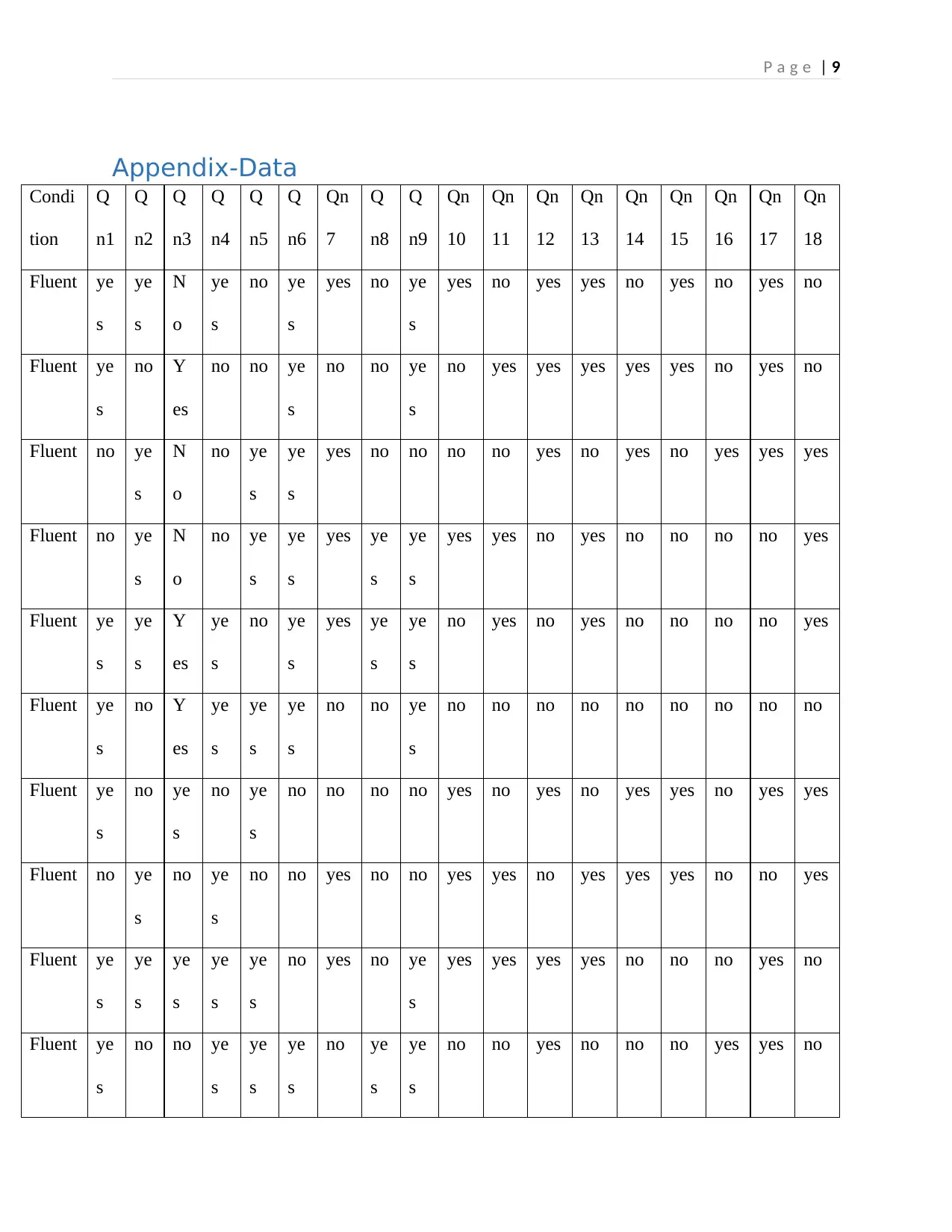
P a g e | 9
Appendix-Data
Condi
tion
Q
n1
Q
n2
Q
n3
Q
n4
Q
n5
Q
n6
Qn
7
Q
n8
Q
n9
Qn
10
Qn
11
Qn
12
Qn
13
Qn
14
Qn
15
Qn
16
Qn
17
Qn
18
Fluent ye
s
ye
s
N
o
ye
s
no ye
s
yes no ye
s
yes no yes yes no yes no yes no
Fluent ye
s
no Y
es
no no ye
s
no no ye
s
no yes yes yes yes yes no yes no
Fluent no ye
s
N
o
no ye
s
ye
s
yes no no no no yes no yes no yes yes yes
Fluent no ye
s
N
o
no ye
s
ye
s
yes ye
s
ye
s
yes yes no yes no no no no yes
Fluent ye
s
ye
s
Y
es
ye
s
no ye
s
yes ye
s
ye
s
no yes no yes no no no no yes
Fluent ye
s
no Y
es
ye
s
ye
s
ye
s
no no ye
s
no no no no no no no no no
Fluent ye
s
no ye
s
no ye
s
no no no no yes no yes no yes yes no yes yes
Fluent no ye
s
no ye
s
no no yes no no yes yes no yes yes yes no no yes
Fluent ye
s
ye
s
ye
s
ye
s
ye
s
no yes no ye
s
yes yes yes yes no no no yes no
Fluent ye
s
no no ye
s
ye
s
ye
s
no ye
s
ye
s
no no yes no no no yes yes no
Appendix-Data
Condi
tion
Q
n1
Q
n2
Q
n3
Q
n4
Q
n5
Q
n6
Qn
7
Q
n8
Q
n9
Qn
10
Qn
11
Qn
12
Qn
13
Qn
14
Qn
15
Qn
16
Qn
17
Qn
18
Fluent ye
s
ye
s
N
o
ye
s
no ye
s
yes no ye
s
yes no yes yes no yes no yes no
Fluent ye
s
no Y
es
no no ye
s
no no ye
s
no yes yes yes yes yes no yes no
Fluent no ye
s
N
o
no ye
s
ye
s
yes no no no no yes no yes no yes yes yes
Fluent no ye
s
N
o
no ye
s
ye
s
yes ye
s
ye
s
yes yes no yes no no no no yes
Fluent ye
s
ye
s
Y
es
ye
s
no ye
s
yes ye
s
ye
s
no yes no yes no no no no yes
Fluent ye
s
no Y
es
ye
s
ye
s
ye
s
no no ye
s
no no no no no no no no no
Fluent ye
s
no ye
s
no ye
s
no no no no yes no yes no yes yes no yes yes
Fluent no ye
s
no ye
s
no no yes no no yes yes no yes yes yes no no yes
Fluent ye
s
ye
s
ye
s
ye
s
ye
s
no yes no ye
s
yes yes yes yes no no no yes no
Fluent ye
s
no no ye
s
ye
s
ye
s
no ye
s
ye
s
no no yes no no no yes yes no
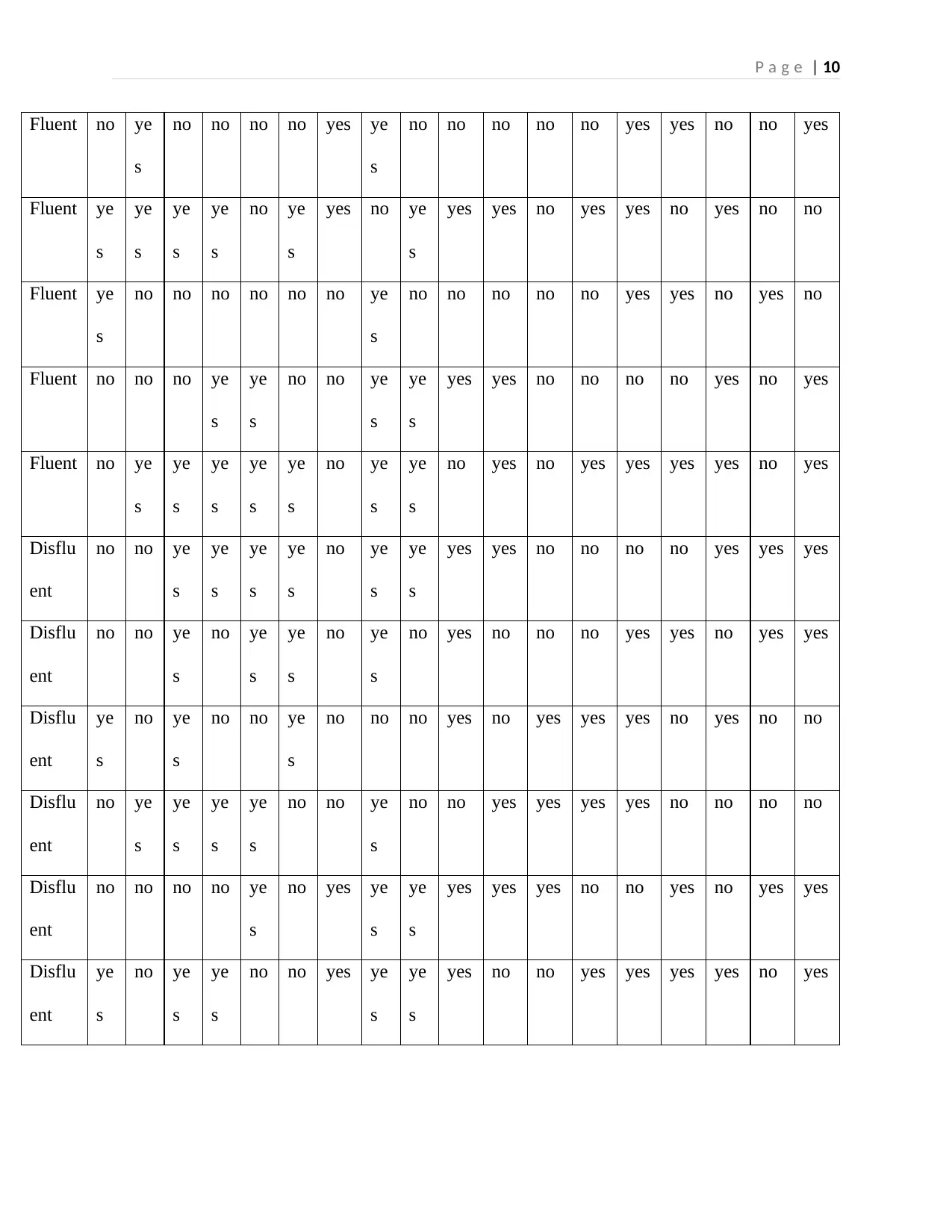
P a g e | 10
Fluent no ye
s
no no no no yes ye
s
no no no no no yes yes no no yes
Fluent ye
s
ye
s
ye
s
ye
s
no ye
s
yes no ye
s
yes yes no yes yes no yes no no
Fluent ye
s
no no no no no no ye
s
no no no no no yes yes no yes no
Fluent no no no ye
s
ye
s
no no ye
s
ye
s
yes yes no no no no yes no yes
Fluent no ye
s
ye
s
ye
s
ye
s
ye
s
no ye
s
ye
s
no yes no yes yes yes yes no yes
Disflu
ent
no no ye
s
ye
s
ye
s
ye
s
no ye
s
ye
s
yes yes no no no no yes yes yes
Disflu
ent
no no ye
s
no ye
s
ye
s
no ye
s
no yes no no no yes yes no yes yes
Disflu
ent
ye
s
no ye
s
no no ye
s
no no no yes no yes yes yes no yes no no
Disflu
ent
no ye
s
ye
s
ye
s
ye
s
no no ye
s
no no yes yes yes yes no no no no
Disflu
ent
no no no no ye
s
no yes ye
s
ye
s
yes yes yes no no yes no yes yes
Disflu
ent
ye
s
no ye
s
ye
s
no no yes ye
s
ye
s
yes no no yes yes yes yes no yes
Fluent no ye
s
no no no no yes ye
s
no no no no no yes yes no no yes
Fluent ye
s
ye
s
ye
s
ye
s
no ye
s
yes no ye
s
yes yes no yes yes no yes no no
Fluent ye
s
no no no no no no ye
s
no no no no no yes yes no yes no
Fluent no no no ye
s
ye
s
no no ye
s
ye
s
yes yes no no no no yes no yes
Fluent no ye
s
ye
s
ye
s
ye
s
ye
s
no ye
s
ye
s
no yes no yes yes yes yes no yes
Disflu
ent
no no ye
s
ye
s
ye
s
ye
s
no ye
s
ye
s
yes yes no no no no yes yes yes
Disflu
ent
no no ye
s
no ye
s
ye
s
no ye
s
no yes no no no yes yes no yes yes
Disflu
ent
ye
s
no ye
s
no no ye
s
no no no yes no yes yes yes no yes no no
Disflu
ent
no ye
s
ye
s
ye
s
ye
s
no no ye
s
no no yes yes yes yes no no no no
Disflu
ent
no no no no ye
s
no yes ye
s
ye
s
yes yes yes no no yes no yes yes
Disflu
ent
ye
s
no ye
s
ye
s
no no yes ye
s
ye
s
yes no no yes yes yes yes no yes
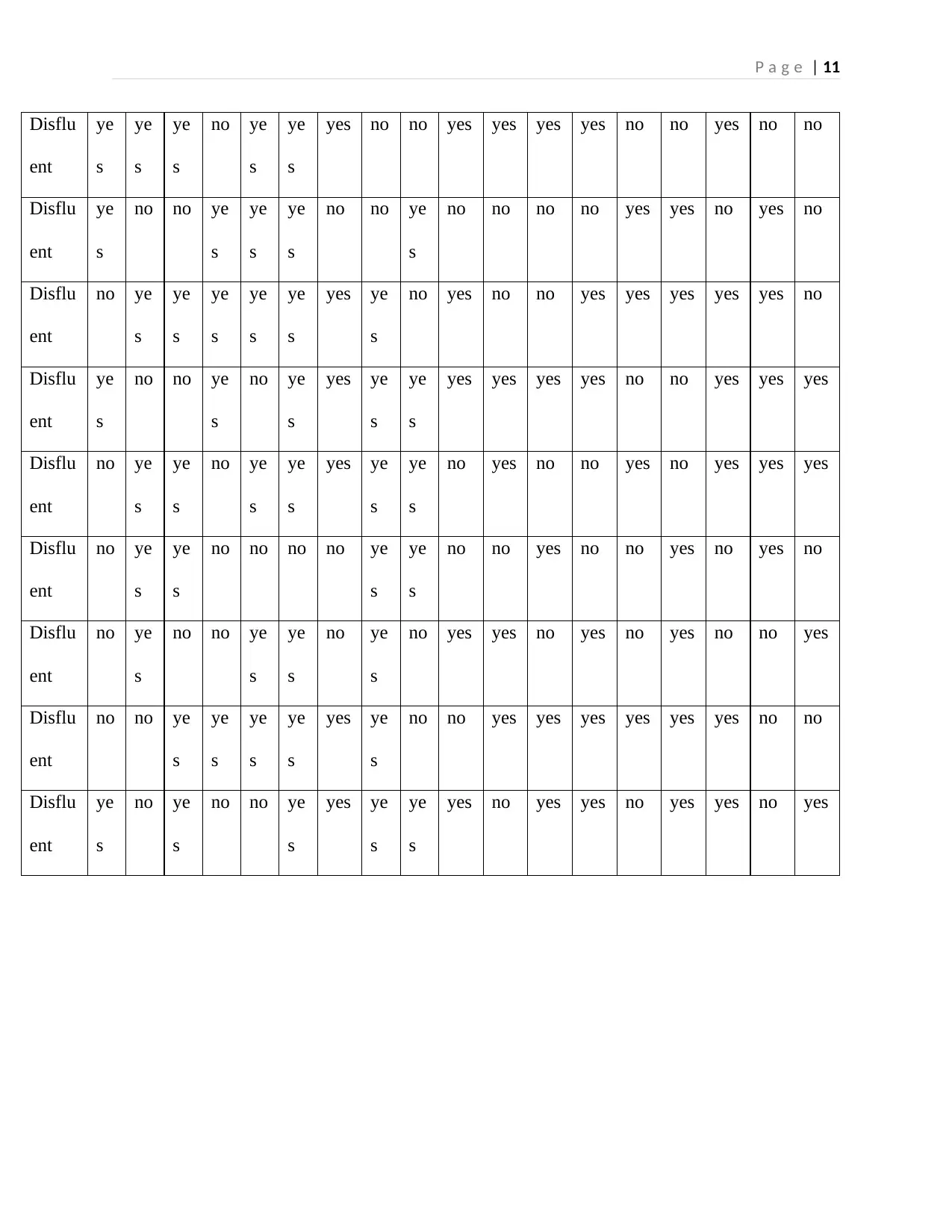
P a g e | 11
Disflu
ent
ye
s
ye
s
ye
s
no ye
s
ye
s
yes no no yes yes yes yes no no yes no no
Disflu
ent
ye
s
no no ye
s
ye
s
ye
s
no no ye
s
no no no no yes yes no yes no
Disflu
ent
no ye
s
ye
s
ye
s
ye
s
ye
s
yes ye
s
no yes no no yes yes yes yes yes no
Disflu
ent
ye
s
no no ye
s
no ye
s
yes ye
s
ye
s
yes yes yes yes no no yes yes yes
Disflu
ent
no ye
s
ye
s
no ye
s
ye
s
yes ye
s
ye
s
no yes no no yes no yes yes yes
Disflu
ent
no ye
s
ye
s
no no no no ye
s
ye
s
no no yes no no yes no yes no
Disflu
ent
no ye
s
no no ye
s
ye
s
no ye
s
no yes yes no yes no yes no no yes
Disflu
ent
no no ye
s
ye
s
ye
s
ye
s
yes ye
s
no no yes yes yes yes yes yes no no
Disflu
ent
ye
s
no ye
s
no no ye
s
yes ye
s
ye
s
yes no yes yes no yes yes no yes
Disflu
ent
ye
s
ye
s
ye
s
no ye
s
ye
s
yes no no yes yes yes yes no no yes no no
Disflu
ent
ye
s
no no ye
s
ye
s
ye
s
no no ye
s
no no no no yes yes no yes no
Disflu
ent
no ye
s
ye
s
ye
s
ye
s
ye
s
yes ye
s
no yes no no yes yes yes yes yes no
Disflu
ent
ye
s
no no ye
s
no ye
s
yes ye
s
ye
s
yes yes yes yes no no yes yes yes
Disflu
ent
no ye
s
ye
s
no ye
s
ye
s
yes ye
s
ye
s
no yes no no yes no yes yes yes
Disflu
ent
no ye
s
ye
s
no no no no ye
s
ye
s
no no yes no no yes no yes no
Disflu
ent
no ye
s
no no ye
s
ye
s
no ye
s
no yes yes no yes no yes no no yes
Disflu
ent
no no ye
s
ye
s
ye
s
ye
s
yes ye
s
no no yes yes yes yes yes yes no no
Disflu
ent
ye
s
no ye
s
no no ye
s
yes ye
s
ye
s
yes no yes yes no yes yes no yes
1 out of 13
Your All-in-One AI-Powered Toolkit for Academic Success.
+13062052269
info@desklib.com
Available 24*7 on WhatsApp / Email
![[object Object]](/_next/static/media/star-bottom.7253800d.svg)
Unlock your academic potential
© 2024 | Zucol Services PVT LTD | All rights reserved.
